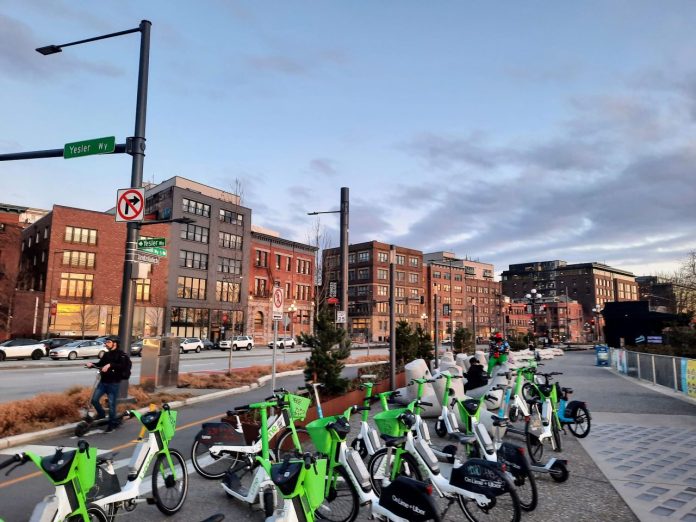
Lime is riding high, as other micromobility operators retool or pull out of Seattle.
Seattle’s dockless bikeshare and scootershare program continues to boom, collectively reaching a new high of nearly five million rides in 2023. That works out to more than 13,000 rides per day.
The Seattle Department of Transportation (SDOT) has touted the versatility and utility of the program. SDOT press secretary Ethan Bergerson stressed the program is a complement for transit and a climate-friendly way to get from point A to B.
“In 2017, Seattle was one of the first major cities to launch a free-floating shared bike program, and our bike and scooter share programs have seen ongoing growth over the last few years,” Bergerson said. “People took 4.9 million bike and scooter trips in 2023, using the shared devices to get to work, parks, recreational facilities, restaurants, shopping, and a wide variety of other activities. It’s a quick, climate-friendly way for people to get to wherever they need to go.”
In particular, shared bike and scooter use has spiked during summer months and on big event weekends. As with King County Metro, bikeshare providers can tip their cap to Taylor Swift for their highest ridership day of 2023.
“Bike and scooter share has proven especially useful to complement transit and help people get to and from crowded areas quickly during major events,” Bergerson said. “This summer, we set a one-day ridership record of nearly 32,000 trips on Saturday, July 22 during Taylor Swift’s concert at Lumen Field.”
SDOT has credited the steady improvement of bike facilities with attracting more people to the mode.
“One of the key reasons for the success of the bike and scooter share program is that we are continuing to invest in bike infrastructure across Seattle,” Bergerson said. “As we continue to build more protected bike lanes and improve our network of Neighborhood Greenways and Healthy Streets, it makes the shared bikes and scooters ever more convenient and accessible.”
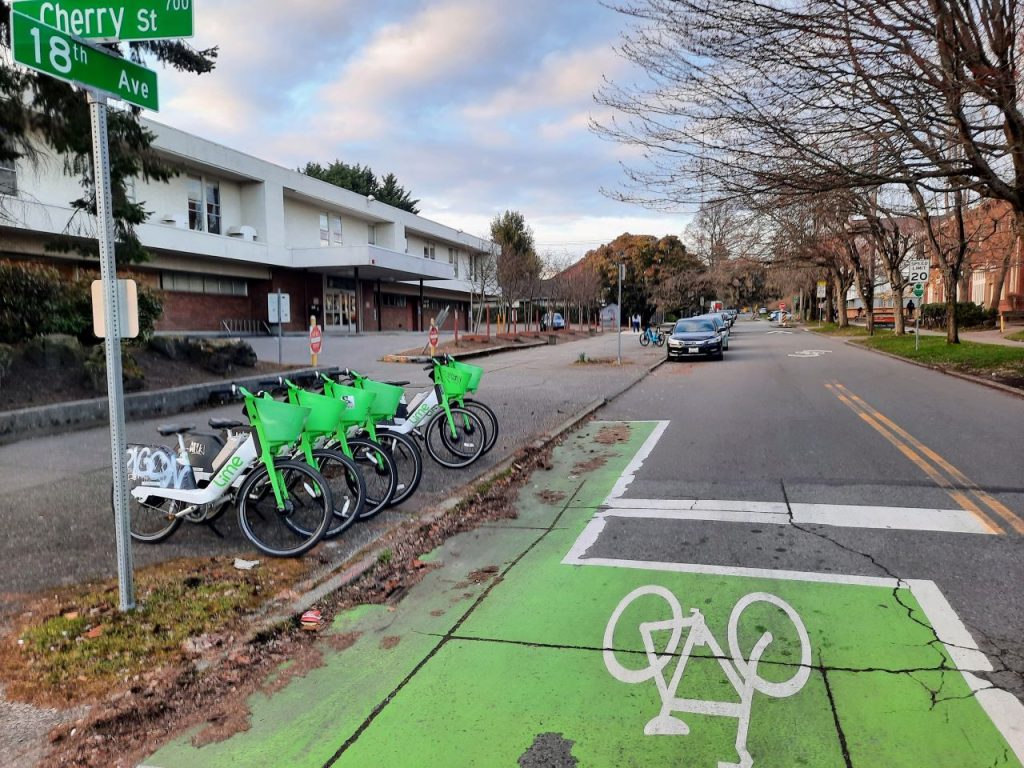
Accounting for more than 60% of trips, Lime is Seattle’s leading provider of both bikeshare and scootershare. Lime’s leadership agreed with SDOT’s assessment, saying the “micromobility program is stronger now than it has ever been.”
“Seattle may be our oldest active market but it continues to set the pace for micromobility programs in the United States and move the idea of shared e-bikes and e-scooters forward,” said Hayden Harvey, Director of Government Relations at Lime. “Ridership continues to break records and each one of those rides represents a potential connection to public transit, a trip that was sustainable instead of in a car, or a long walk that was shortened and made more convenient. We are grateful for the City’s focus and commitment to decarbonizing transportation, and happy to be Seattleites first choice when getting around on two wheels.”
Lime’s 2023 usage was up 50% over 2022, the company said, and that momentum has carried into 2024, with 55% growth in January and an even bigger uptick in February. “Lime riders took an estimated 190,000 rides in February 2024, up 77% from February 2023,” Lime said.
E-bikes are booming broadly in the region as prices have come down and interest spiked in transit alternatives during the pandemic, when transit service levels decreased and Seattleites were encouraged to avoid crowded situations and practice physical distancing.
Bikeshare’s weird and windy road
Bikeshare has faced a weird and windy path in Seattle, with some false starts along the way. In 2014, Seattle launched a municipal bikeshare program with docks, which was called Pronto Cycle Share. However, Mayor Ed Murray and the Seattle City Council pulled the plug on Pronto in 2017 as the City balked at investments needed to maintain and expand the program with the addition of e-bikes.
That briefly left Seattle without a bikeshare program, but in August 2017 SDOT launched a new program using a public-private partnership with vendors offering dockless bikes. These startup companies were flush with investor cash at the time and soon flooded the city in bikes that were cheaply built but priced aggressively at just $1 per 30-minute ride initially as the companies battled to capture the market.
Given the low prices and proliferation of bikes, bikeshare ridership took off, reaching a million rides within its first year across the three initial providers. But it also was quickly becoming apparent the business model wasn’t working for many of the companies. In 2018, Chinese bikeshare company ofo pulled out of Seattle (and much of the U.S. market) entirely and by 2020 had folded under a mountain of debt. Spin, meanwhile, announced it was abandoning bikeshare and pivoting to scooters. That left Lime bikeshare on top.
Despite having the Seattle market mostly to itself for a time, raising prices significantly from those early one-dollar ride days, and still seeing significant ridership, Lime still was not turning the profit it hoped to and it wound down service and laid off staff at the end of 2019. Lime’s decision may have stemmed from Jump, a startup that was bought by Uber in 2018, entering and gaining a big share of the market. Plus, operators were starting to focus on e-scooters as a long-floated scootershare program finally emerged in 2020 after much foot dragging by the Durkan administration. Lime promised it was coming back.
The Jump versus Lime battle never happened, however, as Jump bought a stake in Lime, who folded the services together. This briefly left Seattle without bikeshare again as the companies processed the merger, but Lime slowly returned its e-bikes to service over the summer of 2020 — now rentable though the Uber app, in addition to the Lime app.
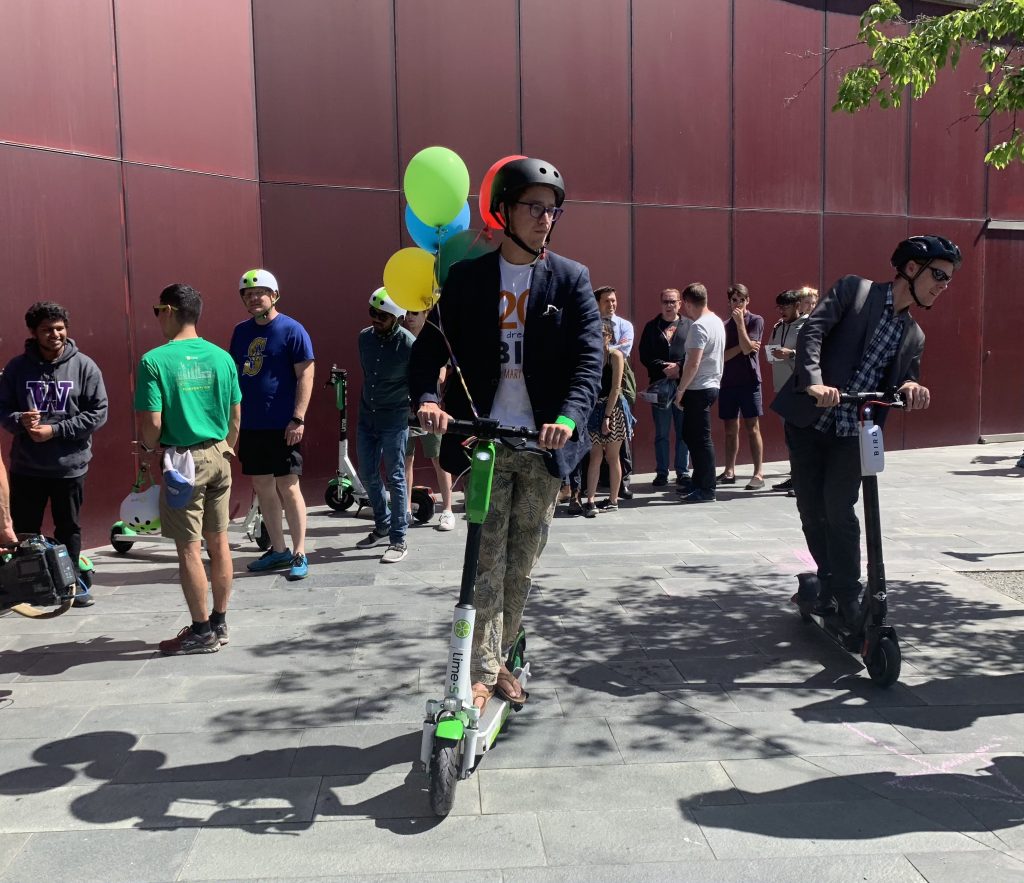
The scootershare pilot launching in late 2020 did turn the companies’ attention away from bikes, at least initially, as scooter companies entered the mix. Scootershare ridership took off and exceeded 10,000 daily trips in August 2021, while bikeshare averaged below 2,000 daily trips all year, as the influx of scooters crowded out bikes. However, bikeshare rebounded in 2022 and continued to grow in 2023.
A record-setting month of July 2023 saw scootershare average 15,600 daily trips and bikeshare average just over 5,400 daily rides.
Despite earlier concerns raised by former Mayor Jenny Durkan and other skeptics that scooters would be hazardous, there’s been no indication scooters are more deadly than any other transportation mode. Bumps, bruises, and broken bones have resulted from users, particularly inexperienced ones, having run-ins with motorists or obstacles in their path. But no increase in road deaths has been linked to the program. Instead, the increase in road deaths locally and nationally has been linked to larger and heavier cars on the road.
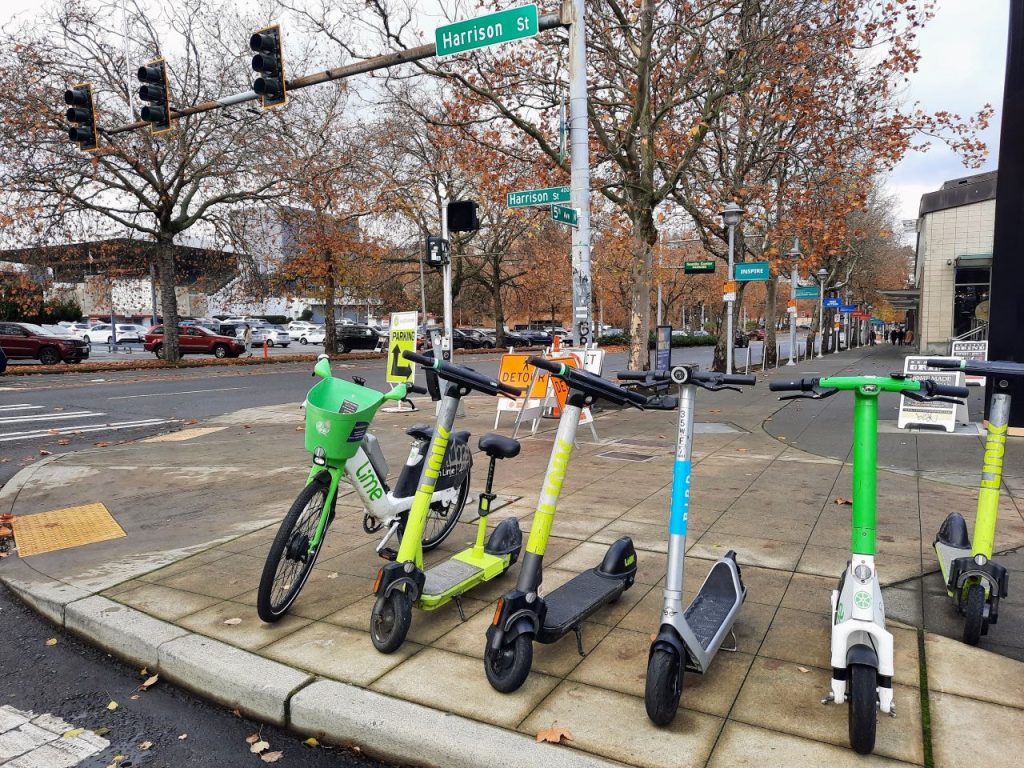
Likewise the worst fears that the micromobility program would pose a massive obstacle on sidewalks and trails appear to mostly have been avoided, outside of the occasional issues with vehicles being strewn about and impeding trails and sidewalk pinch points.
“We are also continuing to work on scooter and bike share parking to keep devices organized for customers and keep sidewalks clear,” Bergerson said. “SDOT manages the service areas and requires scooter and bike share companies to use GPS technology to control bike/ scooter movement and parking in certain areas. SDOT works collaboratively with the companies to ensure that these areas are working well.”
Of course, improvements are always welcomed, which in many cases could will include SDOT widening busy sidewalks and trails, or more quickly enforcing the rules when there are obstructions from parked scooters or bikes — or the proliferation of sandwich boards and other signage impeding sidewalks and decreasing the clear zone. This can be a huge issue, especially for people with disabilities or parents with strollers.
Lime gains as other providers pull out
In 2023, Lime is once again the undisputed leading provider in Seattle for both bikeshare and scootershare. For the year, Lime clocked 2.5 million Seattle scooter trips in 2023 and more than 800,000 bikeshare trips. No other company hit one million trips.
“Lime loves Seattle and Seattle riders love Lime, choosing our e-bikes and e-scooters for two out of every three micromobility rides in the city,” Lime spokesperson Jacob Tugendrajch said. “Ridership is booming because Seattle is successfully building the transportation infrastructure to truly integrate micromobility into its robust transit network. We are happy to work with Seattle to build on that success wherever possible.”
Link by Superpedestrian scootershare was its closest competition with just over 700,000 trips on the year. However, Superpedestrian opted to pull out of Seattle at year’s end.
On Thursday, Veo announced they were pulling their e-bikes from Seattle today, but said they were intending to relaunch with a new fleet. Veo’s vehicles had been a unique bike/seated scooter hybrid vehicle with seats but foot rests rather than traditional bike pedals. The planned new fleet would be conventional e-bikes, it appears.
“[T]his pause is necessary for us to make significant improvements to our service,” Veo wrote. “We’re excited to announce that we’ll be introducing refreshed Cosmo e-bikes equipped with upgraded technology. These upgrades will result in more available vehicles that are reliable, and will provide a smoother, more efficient riding experience for you.”

Veo portrayed the hiatus as lasting just a few weeks, and shared a promo code of SPRING24 for $10 in ride credit to lessen the sting while users wait for vehicles to be available again. Veo averaged more than 1,300 deployed vehicles in 2023, but it’s not clear what service level they will maintain with the new vehicles.
While Veo is out of service, that leaves just Bird scooters as Lime’s competition for now. However, Bird filed for bankruptcy in December so it’s not clear how long they can sustain operations either. Lime’s sizable fleet averaged just over 4,000 deployed vehicles in 2023. Bird averaged almost 1,900 scooters deployed in 2023, but has culled their deployment back a bit in the winter months, which is in line with the typical summer-peak seasonality among operators.
Companies are charging much higher rates than they did in the early days.
Lime e-bikes and scooters are currently priced at $1 to unlock and $0.45 per minute. That can add up quickly, but the Lime pass option can cut costs for longer trips or periods of high usage. Lime has priced 60 minutes of ride time at $11.99 for that option, waiving the unlock fees, but the credit is timed to expire after three days. Lime also has a longer 180-minute week pass for $33.99 or 280-minute month pass for $42.99. Pricing at rival companies is similar.
Outside of some no-go zones, Lime’s service area covers the entirety of Seattle city limits, which means it’s grown well beyond Pronto’s original scope. Lime also has a few limited service zones in Bothell and Redmond. Lime briefly operated in Bellevue under a pilot program, but pulled out in 2019.
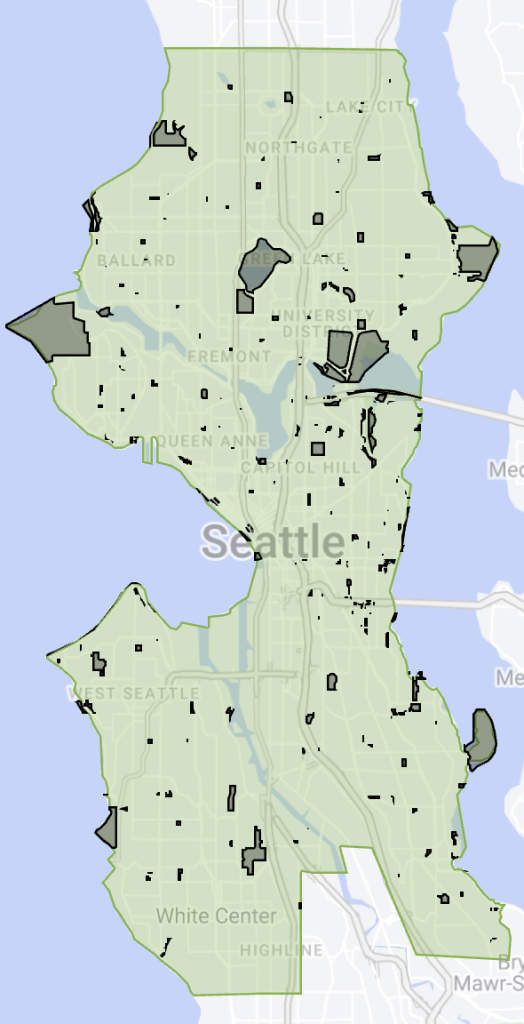
Demand for first-mile/last-mile solutions that extend the range of transit is likely to jump later this year as the East Link and Lynnwood Link light rail extensions open. As it stands, Lime has no imminent plans to expand its range, but the company didn’t rule out the possibility.
“Seattle ridership is booming and we’re open to building on our success in the city with expansion to neighboring areas, and any move to do so would be done working as partners to those areas and their local stakeholders,” Tugendrajch said.
Another issue that has emerged for Seattle users is that many Seattle Parks properties remain off-limits to shared bikes and scooters. SDOT sets the service boundaries and said it was open to revisions to increase access to major parks. More on that in a future article.
Doug Trumm is publisher of The Urbanist. An Urbanist writer since 2015, he dreams of pedestrianizing streets, blanketing the city in bus lanes, and unleashing a mass timber building spree to end the affordable housing shortage and avert our coming climate catastrophe. He graduated from the Evans School of Public Policy and Governance at the University of Washington in 2019. He lives in East Fremont and loves to explore the city on his bike.


